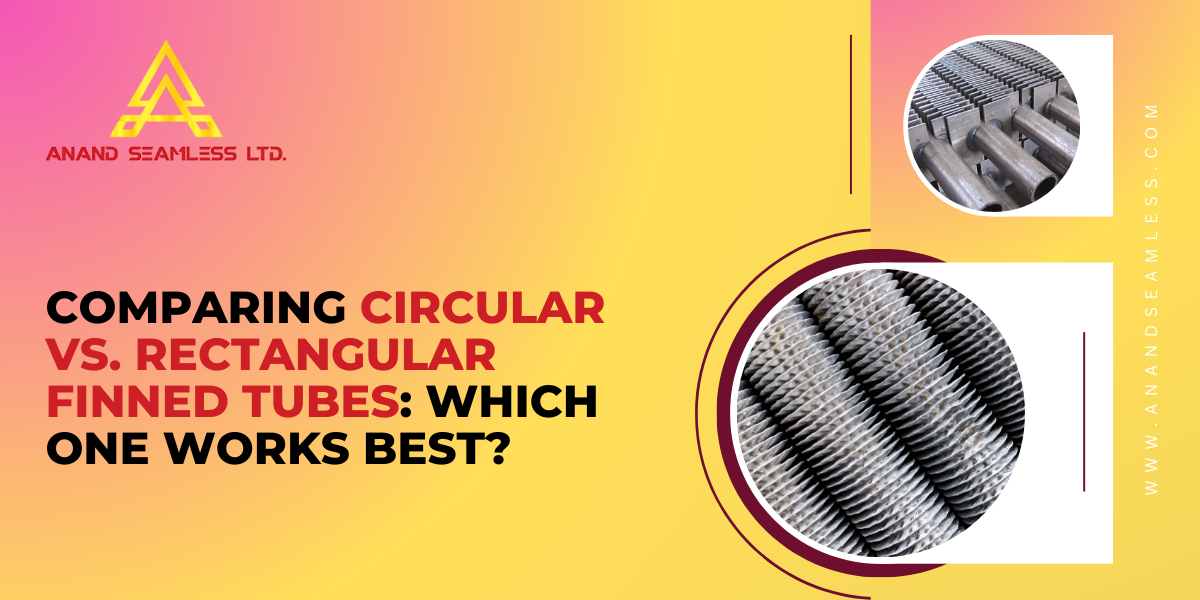Quick Inquiry
In heat transfer applications, finned tube heat exchangers play a crucial role in optimising thermal efficiency. Businesses across various industries, from power plants to HVAC systems, rely on these exchangers to enhance heat dissipation. Among the key design choices in finned tube technology, the debate between circular and rectangular finned tubes is significant. Both designs have distinct advantages and limitations, influencing performance, cost, and application suitability. This article explores these two configurations, helping businesses determine the best option for their specific needs.

The Role of Finned Tube Heat Exchangers
Finned tube heat exchangers enhance heat transfer by increasing the surface area exposed to the surrounding fluid. This increased surface area facilitates more efficient heat dissipation, making them ideal for applications requiring temperature regulation and heat recovery. Various industries, including petrochemicals, power generation, refrigeration, and HVAC, use these exchangers to maximise operational efficiency while reducing energy consumption.
Circular Finned Tubes: Advantages and Applications
Circular finned tubes are among the most common choices in heat exchanger design. They consist of a cylindrical tube wrapped with circular fins, ensuring uniform heat distribution and efficient thermal performance.
Advantages of Circular Finned Tubes
- Optimised Heat Transfer Efficiency: Circular fins create an even distribution of heat, improving overall exchanger performance.
- Durability and Structural Integrity: These tubes exhibit better resistance to thermal stress and mechanical loads, ensuring longer service life.
- Ease of Cleaning and Maintenance: The uniform geometry allows easier cleaning, reducing the risk of debris accumulation and scaling.
- Wider Availability: Fin tube manufacturers in Ahmedabad such as Anand Seamless Limited offer circular finned tubes as a standard option, ensuring easy availability and cost-effectiveness.
Applications of Circular Finned Tubes
- HVAC systems for air heating and cooling
- Power plants for steam condensers
- Petrochemical industries for heat recovery
- Industrial dryers and food processing units
Rectangular Finned Tubes: Advantages and Applications
Rectangular finned tube heat exchangers, also known as square or flat-finned tubes, feature flat, plate-like fins arranged perpendicularly to the tube’s surface. This design offers unique advantages that cater to specific industrial requirements.
Advantages of Rectangular Finned Tubes
- Higher Heat Transfer Rates: Due to their broader surface area, rectangular fins facilitate higher rates of heat dissipation compared to circular fins.
- Compact Design: These tubes allow for more efficient packing in constrained spaces, making them suitable for compact heat exchanger designs.
- Improved Airflow Dynamics: The flat fin structure can enhance airflow, reducing pressure drop and improving energy efficiency in forced convection systems.
- Better Performance in Fouling Environments: Rectangular fins reduce the likelihood of dust accumulation, making them ideal for industries dealing with airborne particulates.
Applications of Rectangular Finned Tubes
- Waste heat recovery systems
- Heavy industrial machinery cooling
- Boilers and economisers
- Aerospace and automotive heat exchangers
Get a Free Detailed Quote Today!
Key Differences: Circular vs. Rectangular Finned Tubes
Feature |
Circular Finned Tubes |
Rectangular Finned Tubes |
| Heat Transfer Efficiency | Moderate to high | Higher due to larger surface area |
| Space Utilisation | Requires more space | Compact design for tight spaces |
| Structural Strength | High durability and resistance to stress | Moderate durability, more suited for stationary applications |
| Airflow Resistance | Lower resistance, ideal for natural convection | Can optimise forced convection applications |
| Maintenance & Cleaning | Easier due to smooth geometry | Requires periodic maintenance in certain environments |
| Suitability for Fouling Environments | Moderate fouling resistance | Better fouling resistance due to flat surfaces |
Choosing the Right Finned Tube Heat Exchanger for Your Application
When selecting the appropriate finned tube design, businesses must consider various factors, including heat transfer efficiency, space constraints, durability, and maintenance requirements.
Here’s how to decide:
- For industries requiring high durability and easy maintenance, circular finned tubes are ideal. They are best suited for power plants, petrochemical industries, and HVAC systems where longevity and reliability are key.
- For applications demanding higher heat transfer rates in compact spaces, rectangular finned tubes provide a superior solution. These are optimal for waste heat recovery systems, industrial cooling, and applications involving forced convection.
- For environments prone to fouling or debris accumulation, rectangular finned tubes offer better resistance and efficiency. Their flat fin structure prevents excessive clogging and ensures better airflow dynamics.
- For cost-conscious projects, circular tubes are more widely available and budget-friendly, as many fin tube suppliers manufacture them in large volumes.
Frequently Asked Questions (FAQs)
1. How does fin geometry impact the overall performance of a finned tube heat exchanger?
The shape and arrangement of fins influence heat transfer rates, airflow resistance, and cleaning efficiency. Circular fins offer uniform heat distribution and structural strength, whereas rectangular fins optimise forced convection and minimise fouling in dusty environments.
2. Are rectangular finned tubes more expensive than circular finned tubes?
Cost depends on the material, manufacturing process, and application requirements. Rectangular finned tube heat exchangers may have a higher initial cost due to their enhanced heat transfer capabilities but can offer long-term savings in specific high-efficiency applications.
3. Which industries benefit the most from using finned tube heat exchangers?
Industries such as power generation, petrochemicals, HVAC, food processing, and automotive cooling systems benefit significantly from finned tubes due to their ability to optimise heat transfer and improve energy efficiency.
4. What is the role of fin tube manufacturers in ensuring product quality?
Reliable fin tube manufacturers in Ahmedabad and other industrial regions follow stringent quality control measures, use high-grade materials, and provide customised solutions to meet industry standards. Partnering with a trusted supplier ensures durability, efficiency, and long-term performance.
5. How do environmental conditions affect the performance of finned tube heat exchangers?
Environmental factors such as humidity, airborne contaminants, and extreme temperature fluctuations can impact the efficiency and longevity of finned tube heat exchangers. In high-humidity environments, corrosion-resistant materials like stainless steel or coated aluminum are recommended to prevent deterioration. Additionally, industries operating in dusty conditions may benefit from rectangular finned tubes due to their improved resistance to fouling.
Partner with Industry-Leading Fin Tube Manufacturer for Optimal Performance
Choosing the right finned tube heat exchanger is critical for operational efficiency and cost savings. At Anand Seamless Limited, we specialise in high-quality finned tubes, providing innovative solutions tailored to your industry’s unique demands.
As a trusted name among fin tube manufacturers in Ahmedabad, we offer a diverse range of finned tubes, ensuring superior heat transfer and durability. Contact us at +91-9099996851 or write to us at inquiry@anandseamless.com to discuss your requirements and discover how our expertise can enhance your heat exchanger performance.
lATEST BLOG |
|
U-Tube vs. Straight-Tube Heat Exchangers: Comparison Guide
Heat exchangers play a crucial role in industries |
|
Destructive vs. Non-Destructive Testing for Seamless Tubes
Seamless tubes play a critical role in industries |
|
The Hidden Costs of Poor-Quality Heat Exchanger Tubes: A Manufacturer’s Perspective
Heat exchangers play a critical role in various in |
|
Seamless Tubes in Boiler and Power Plants: Why They Are a Game-Changer
Seamless tubes are crucial in various industrial a |
|
Comparing Circular vs. Rectangular Finned Tubes: Which One Works Best?
In heat transfer applications, finned tube heat ex |

